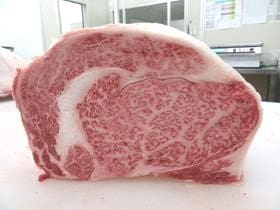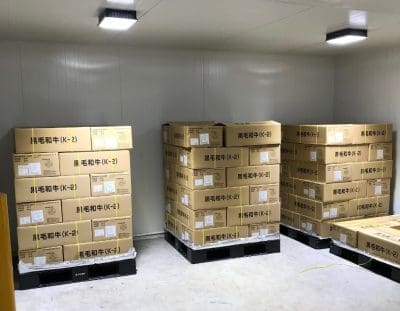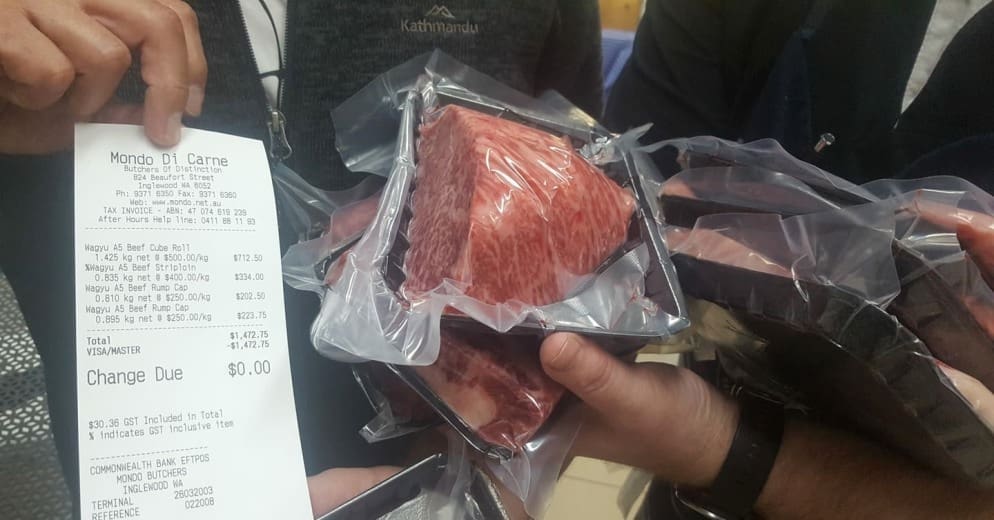AT LEAST two consignments of highly-marbled Japanese Wagyu beef, both from the revered Kagoshima prefecture in the country’s south, arrived in Australia in late July and have already been sold to the public.
While only small in volume, the new trade has symbolic significance, marking the end of a 17-year ban on beef imports from Japan to Australia following the country’s detection of BSE in 2001.

Japanese A5 grade Wagyu cube roll from Clover Valley’s first consignment last week
In fact it is questionable whether any Japanese beef has every entered Australia previously, as Wagyu was only just starting to come onto the ‘foodie radar’ in 2001, supply chain participants told Beef Central.
As we reported earlier in this article, Japan officially regained access to the Australian market for chilled and frozen beef in late May – the first time in at least 30 years that any country has gained, or re-gained beef market access to Australia. Up to then, the only countries entitled to export beef to Australia were New Zealand, and curiously, Vanuatu – both of which carry the OIE’s same ‘least-risk’ BSE rating as Australia.
Tokyo had been pressing for a resumption of access to Australia for beef exports since 2004.
Technical requirements and approvals necessary for trade to commence were completed and signed-off in late May, meaning all that remained for trade to commence was the need for an importer/exporter to apply for an import permit.

Clover Valley’s first consignment of imported Japanese Wagyu in cold storage in Sydney, before distribution across Australia last week
Australian Wagyu beef exporter, Clover Valley Meat Co, received its permit in late June, and completed its first shipment before the end of July. The consignment, through Japanese exporter Itoham, one of the nation’s largest Wagyu beef suppliers, was all Japanese A4 and A5 high grade product. The consignment of a little over a tonne included striploins, tenderloins, cube rolls, topsides and point-end brisket and short-rib.
Almost all of it will find its way into high-end restaurants and hotels, but some will be found in specialty retail sites (see list below).
At much the same time, niche Australian Wagyu beef exporter Osawa Enterprises, headed by Kimio Osawa, imported around 200kg of chuck rib and short-rib meat into Australia, also from the Kagoshima region. Osawa exports some of Australia’s best known Wagyu Fullblood brands around the world.
An earlier attempt to start the new trade did not go smoothly, however. On 19 July a high-end Japanese restaurant in North Sydney attempted to import a small 50kg consignment of chuck roll and clod from Japan’s Hida Meat Centre, but the consignment was rejected by Australian authorities because it did not arrive with appropriate permits.
Clover Valley managing director Clayton Wright said his consignment had wholesaled for around A$200/kg, with some cuts worth more than others. The shipment included Itoham’s Cherry Blossom brand A5 Wagyu, which was a major winner in the prestigious 11th National all-Japan Beef Expo held at Sendai last year (se Beef Central’s earlier reports).
Mr Wright said while Japanese Wagyu exports to Australia were unlikely to every reach significant quantities, it obviously had significant ‘novelty value’ in the market under the current circumstances.
“The food industry loves scarcity in any premium commodity, and this certainly fills that bill,” he said.
As Clover Valley’s wholesale arm, Wrights the Butchers, was preparing the product for distribution to customers, comparisons were made with cut samples of some of Australia’s highest marbled Wagyu beef brands, revealing considerably higher marbling in the Japanese samples.
“We could definitely see the point of difference in the cutting room,” Mr Wright said.
He said the Department of Agriculture’s biosecurity and imported foods personnel “did an excellent job in seeing that the import was safe and sound – as we would expect.”
“They were incredibly thorough, from start to finish, with the monitoring of this shipment.”
As is customary with all Japanese Wagyu beef, each carton came with certificates identifying details about the animals, the breeder, the feedlot and the abattoir through which they came, complete with the a nose-print unique to each animal. Some of these are being displayed by restaurant end-users.
Retailing at $500/kg
Not surprisingly, early Australian end-users have made a lot of noise about access to the beef.
One of Clover Valley’s customers Perth celebrity butcher Vince Garaffa, posted this image, racking-up a sale through his Mondo de Carne shop worth $1472.25 for less than 3kg of A5 Japanese cube roll, striploin and rump cap. That works out at just under $500/kg. Mondo has sold more than 120kg of the Japanese beef since Friday.
Food service users to receive supplies included Black restaurant at Star City Casino, the Shangri la Hotel and Tetsuya’s in the Sydney CBD. The initial shipment found its way into the Sydney, Brisbane, Surfers Paradise, Melbourne, Adelaide, and Perth markets.
Mr Wright said judging by the response the first consignment had received (some customers like Mondo had already sold-out of their first orders), it was likely further shipments would follow.
“I think this is fantastic for the local Wagyu industry, as it sets a benchmark for our local producers and gives some local consumers the opportunity to see the beef in real-time, instead of traveling to Japan,” he said.
“It will never compete against our local beef on price, but offers another Wagyu avenue for consumers to enjoy and appreciate, and possibly continue the debate about ‘What is Wagyu’.”
Mr Wright recognised that it was possible that some Australian beef industry stakeholders might not be comfortable with the importation.
“Some may ask, why wouldn’t you support Australian farmers, or what’s the matter with Australian beef? The fact is there’s absolutely nothing wrong with it, but discerning consumers like variety. If anything, the presence of small quantities of Japanese Wagyu here may in fact boost interest in Australia’s own Wagyu beef.”
To date, there are only four registered Japanese beef plants approved for export into Australia, he said.
Australian Meat Industry Council chairman Lachie Hart – himself a prominent Australian Wagyu supply chain manager – said Australia fundamentally supported free trade in beef, and provided it met science-based standards for food safety and hygiene, that meant imports, as well as exports.
“We need to be open with regard to our own borders, as well as seeking market access overseas ourselves,” Mr Hart said.
AMIC’s principal concern with the process remained the biosecurity of any fresh meat arriving in Australia from overseas, and the need for the various government departments to maintain due diligence to ensure that any products coming in are safe – not just for consumers, but for the broader beef industry.
Mr Hart said the US had an application in place for access for US beef to the Australian market, but it was believed that outcome was still some way off. Similarly, some rose veal was likely to be permitted to be imported from the Netherlands at some time – possibly within the next 12 months – as a result of an import application currently being examined.
“Interest from the US remains, because access to Australia would provide good leverage to access other markets not currently available to US exporters,” he said.
Mr Hart did not anticipate any significant beef industry opposition to the Japanese import development.
“If it happens, it may be related to concerns expressed about biosecurity breaches such as the recent white spot outbreak in prawns, and the risk of importation of FMD in blood plasma products recently illegally imported from South America,” he said.
“They are important wake-up calls, and for the man on the land, are likely to be the risk of greatest concern. We place a lot of faith in the regulatory system to appropriate manage disease risk. The safest biosecurity measures happen in the country in which the product is produced, rather than waiting until it arrives in Australia,” Mr Hart said.
Sourcing Japanese imported Wagyu beef
For those readers with very deep pockets, here is a list of some retail outlets selling the unique Japanese Wagyu product. Some may already have run out of initial supply:
- Wrights the Butchers: 73 Burrows Road Alexandria Ph 02 95570066
- Standard Meat Market: 107 Ferry Road Southport Queensland ph 07 55886999
- Gary’s Quality Meats: Commercial Road, Prahran Market Melbourne ph 03 98260815
- Mondo de Carne Butchers: 824 Beaufort Street Inglewood Western Australia ph 08 93716350

